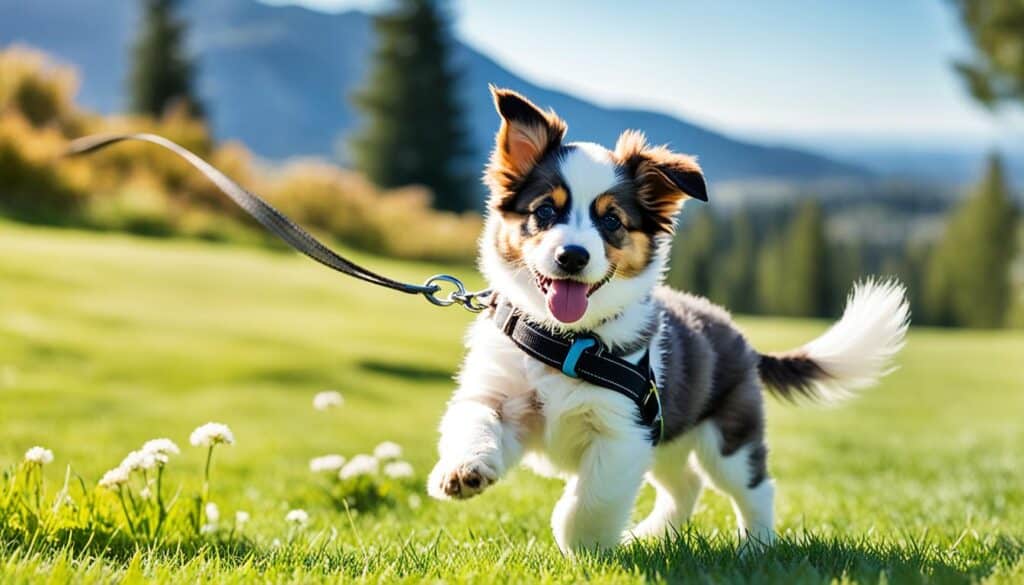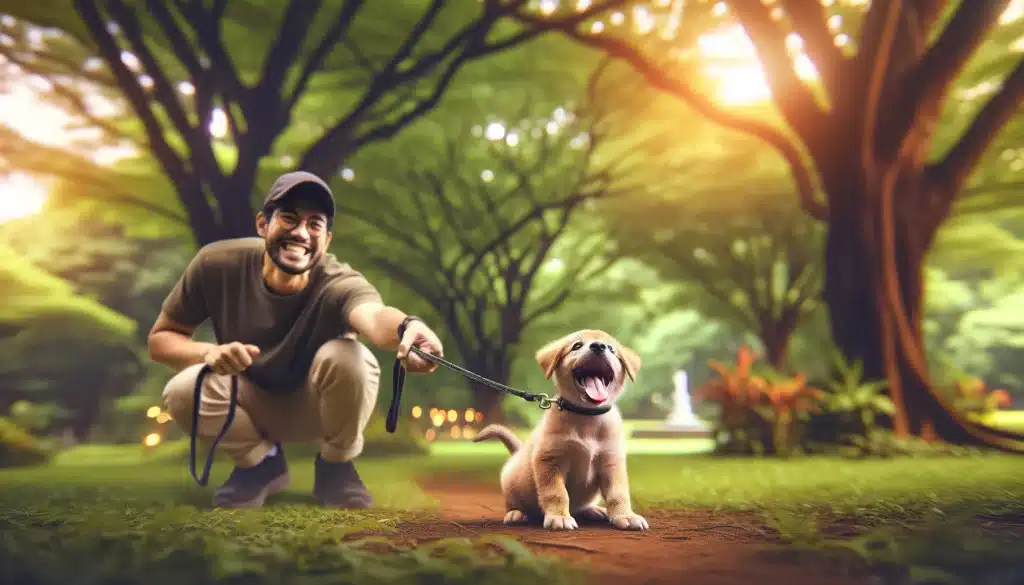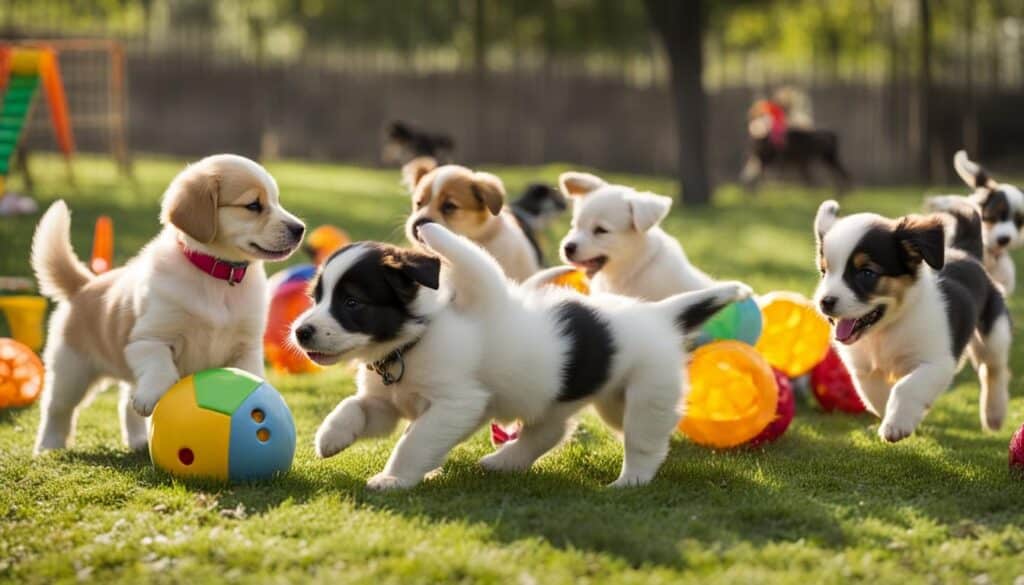Leash training a puppy is crucial to raising a well-behaved and obedient dog. It not only ensures the safety of your furry friend but also promotes good behavior and leash manners. However, many dog owners often find leash training to be a challenging task. The good news is that you can achieve successful leash training with your puppy with the right approach and simple steps.
In this article, we will explore the keys to successful leash training and provide you with simple-to-follow steps to train your puppy effectively. Whether you are a first-time dog owner or looking to improve your leash training skills, this guide will equip you with the knowledge and techniques to make the process easier and enjoyable for you and your furry companion.

Key Takeaways:
- Leash training is essential for a puppy’s safety and behavior.
- Choosing the right leash and harness is essential for successful training.
- Gradually introducing your puppy to the leash and harness is crucial.
- Following simple steps and techniques can make leash training more accessible.
- Positive reinforcement plays a significant role in leash training.
Why is it Important to Leash Train Your Puppy?
To ensure a safe and well-behaved furry companion, leash training your puppy is of utmost importance. Understanding the benefits and reasons behind leash training will empower you to provide the top care and guidance for your puppy’s development. By investing time and effort into leash training, you can establish a strong foundation for a lifetime of positive experiences together.
Understanding The Importance of Leash Training A Puppy
Leash training serves multiple purposes and contributes to your puppy’s overall well-being. One of the critical reasons for leash training is to ensure their safety. When adequately trained on a leash, your puppy is less likely to run into dangerous situations, such as traffic or off-leash encounters with aggressive dogs.
Leash training also helps to improve your puppy’s behavior. It teaches them self-control and walking calmly without pulling, lunging, or jumping. This in turn fosters good leash manners and prevents leash-related behavioral problems.
Critical Reasons to Leash Train Your Dog
Leash training has numerous benefits that extend beyond safety and behavior. By leash training your puppy, you provide them with much-needed mental and physical stimulation. Regular walks on a leash allow your puppy to explore their surroundings, experience different environments, and engage with new stimuli.
Leash training also forms a strong bond between you and your puppy. It establishes trust, communication, and mutual understanding, strengthening the relationship and allowing for better obedience and responsiveness. Additionally, leash training promotes socialization, exposing your puppy to different people, animals, and situations, helping them become well-rounded and confident dogs.
Benefits of Leash Training
- Enhanced safety for your puppy
- Improved behavior and leash manners
- Increased mental and physical stimulation
- Stronger bond between you and your puppy
- Promotes socialization and confidence
What You Need to Know Before You Begin Leash Training
Before embarking on leash training your puppy, you must be well-prepared and equipped with the necessary knowledge and tools. This section will guide you through the essential steps to ensure a successful leash training journey for you and your furry friend.
Picking The Right Leash and Harness For Your Puppy
Choosing the right leash and harness is crucial for practical leash training. The leash should be strong, durable, lightweight, and comfortable for you and your puppy. Opt for a leash made of nylon or leather that is about 4-6 feet long for optimal control.
Consider your puppy’s size, breed, and walking style regarding harness selection. For more miniature puppies or those prone to pulling, a front-clip harness can help redirect their attention and discourage pulling. Larger breeds or well-behaved puppies may do well with a back-clip or no-pull harness.

Introducing Your Puppy to The Leash and Harness
Once you have the right leash and harness, you must introduce your puppy to these new accessories positively and gradually. Start by placing the harness on your puppy while they are indoors, allowing them to get used to the sensation of wearing it. Offer treats and praise to create positive associations with the harness.
Next, attach the leash to the harness and allow your puppy to drag it around the house or in a secure area. This helps them become familiar with the weight and presence of the leash. Reward your puppy when they interact positively with the leash, such as sniffing or playing.
Once your puppy is comfortable with the leash and harness indoors, you can start taking short walks together in a quiet and familiar environment. Keep the walks relaxed and fun, rewarding your puppy for walking beside you and following your lead.
Patience and consistency are critical during the introduction phase. Gradually increase the duration and difficulty of the walks as your puppy becomes more comfortable and confident with the leash and harness.
| Leash Type | Key Features | Suitable For |
| Nylon Leash | Durable and lightweight | All puppy breeds |
| Leather Leash | Strong and comfortable | All puppy breeds |
| Front-Clip Harness | Discourages pulling | Small and pulling-prone puppies |
| Back-Clip Harness | Comfortable and versatile | Medium to large breeds |
Simple Steps to Leash Train Your Puppy
Leash training is an essential aspect of raising a well-behaved and obedient puppy. By following these simple steps, you can effectively teach your furry friend to walk on a leash and enjoy strolls together. Let’s dive into the basic dog training techniques for leash walking, learn how to handle your puppy pulling on the leash, and discover ways to teach your puppy to walk beside you easily.
Basic Dog Training Techniques For Leash Walking
Regarding leash walking, it’s crucial to start slowly and gradually introduce your puppy to the concept of walking on a leash. Here are a few fundamental dog training techniques to get you started:
- Get your puppy accustomed to wearing a collar or harness by letting them wear it indoors for short periods.
- Attach a lightweight leash to the collar or harness and allow your puppy to drag it around while supervised.
- Reward your puppy with treats and praise when they show interest in the leash or voluntarily follow you while wearing it.
- Practice in a quiet and familiar area, gradually increasing the duration of leash walks.
- Use treats and positive reinforcement to encourage your puppy to walk beside you, rewarding them when they stay close and focus on the walk.
How to Handle Your Puppy Pulling on the Leash
Puppy pulling is a common challenge during leash training, but it can be effectively managed with the following techniques:
- Stop walking and stand still when your puppy starts pulling on the leash. Avoid yanking or pulling back; wait until they ease the tension on the leash.
- Once your puppy has relaxed the tension, resume walking and reward them for walking beside you.
- Practice leash walking exercises that involve direction changes to keep your puppy engaged and focused on you.
- Consider using a no-pull harness or head halter if your puppy continues to pull excessively. These tools can provide additional control and discourage pulling behavior.
Teaching Your Puppy to Walk Beside You With Ease
Walking beside you is an essential skill for your puppy to learn. Use the following techniques to teach them how to walk comfortably by your side:
- Start by getting your puppy’s attention with treats or a favorite toy. Hold it by your side to encourage them to walk alongside you.
- Use a verbal cue, such as “heel” or “let’s go,” and reward your puppy when they walk beside you.
- Maintain a consistent pace and reward your puppy for staying beside you throughout the walk.
- Practice reinforcing the desired behavior by incorporating short training sessions during each leash walk.
- Gradually reduce the frequency of treats, but continue to praise and reward your puppy for walking nicely beside you.
Leash training takes time and patience. Be consistent, stay positive, and celebrate small victories along the way. With these techniques, you’ll be well on your way to enjoying peaceful walks with your puppy.

How to Ensure Successful Leash Training With Positive Reinforcement
In leash training your puppy, positive reinforcement is a powerful technique that can lead to successful outcomes. You can establish a strong bond and create a positive learning environment by focusing on positive association and rewarding your dog during training sessions.
The Role of Positive Association in Puppy Leash Training
Positive association plays a crucial role in leash training your puppy. It involves associating the leash and training sessions with positive experiences such as treats, praise, and playtime. By consistently providing positive reinforcement, your puppy will begin to associate the leash with enjoyable activities and look forward to training sessions.
To create positive associations:
- Start by introducing the leash gradually and in a calm environment.
- Allow your puppy to sniff and explore the leash before attaching it.
- Use treats and praise to reward your puppy for showing curiosity and calm behavior around the leash.
How to Reward Your Dog During Leash Training Sessions
Rewarding your dog during leash training sessions is essential for reinforcing desired behaviors. You can motivate your dog to follow commands and maintain good leash manners by using rewards such as treats, praise, and playtime.
When rewarding your dog, be prompt and consistent. Immediately praise and offer a treat when your dog walks calmly on the leash or responds to your commands. Use a high-value treat to make the reward extra enticing and reinforce positive behaviors effectively.
It’s important to note that rewards should be given immediately after the desired behavior occurs, so your dog can connect the behavior and the reward. Consistency and patience are essential when using rewards to encourage positive leash training.
Positive reinforcement is a gentle and effective way to train your puppy. It promotes a trusting relationship between you and your dog while encouraging them to learn and behave positively. Incorporating positive training techniques can ensure successful leash training and help your puppy become a well-behaved companion.
Common Problems and Solutions During Leash Training a Puppy
Leash training a puppy can sometimes be challenging, and many dog owners encounter common problems. Understanding these issues and having solutions at hand can make the training experience smoother and more successful. This section will discuss two common issues dog owners may face during leash training and provide practical solutions to overcome them.
How to Stop Your Puppy From Walking Away When on Leash
One familiar problem dog owners may encounter is when their puppy consistently tries to walk away or pull in different directions on the leash. This behavior can be frustrating and make leash training ineffective. Fortunately, there are several strategies you can employ to address this problem:
- Ensure a proper fit: Ensure your puppy’s harness or collar is correctly fitted. It should be snug enough to prevent slipping out but not too tight to cause discomfort.
- Use positive reinforcement: Encourage your puppy to stay close to you by using treats or toys as rewards. Offer these rewards when your puppy walks beside you or looks at you while on the leash.
- Practice leash manners: Set aside regular training sessions to teach your puppy good manners. Start in a low-distraction environment and gradually increase the difficulty as your puppy improves.
Dealing With A Puppy That Doesn’t Respond to Leash Pressure
Another common issue during leash training is when a puppy doesn’t respond to leash pressure or pulling. This can make guiding your puppy and maintaining control during walks difficult. Here are some solutions to address this problem:
- Focus on positive reinforcement: Instead of relying solely on leash pressure, use positive reinforcement techniques to encourage your puppy to respond to your cues. Reward your puppy when they react to light leash pressure by walking in the desired direction.
- Be patient and consistent: Leash training takes time, especially for puppies who may be easily distracted or unfamiliar with the concept. Stay patient and consistent with your training efforts, praising and rewarding your puppy for progress.
- Seek professional help if needed: If your puppy struggles with leash pressure despite consistent training, consider seeking guidance from a professional dog trainer. They can provide personalized advice and techniques to address your puppy’s needs.
| Common Problems | Solutions |
| Puppy walking away when on the leash | 1. Ensure a proper fit of the harness or collar2. Use positive reinforcement to encourage staying close3. Practice leash manners with regular training sessions |
| Puppy not responding to leash pressure | 1. Focus on positive reinforcement2. Be patient and consistent3. Consider seeking professional help if needed |
Continuing Your Leash Training Journey: From Puppy to Senior Dog
Leash training is an ongoing process that extends beyond the puppy stage. As your furry friend grows from a cute little puppy to a wise senior dog, it’s essential to maintain good leash manners and continue their training journey. By doing so, you can ensure their safety and enjoyment while on walks, regardless of age.
Maintaining Good Leash Manners as Your Puppy Grows
As your puppy matures, it’s essential to reinforce and maintain the excellent leash manners they learned during their initial training. Consistency is vital in maintaining their behavior, so practice leash walking regularly. Remember to reward and praise your dog for walking beside you calmly and not pulling on the leash. Reinforcing these positive behaviors will help your dog understand and exhibit good leash manners.
Advanced Leash Training Techniques for Continued Success
Once your dog has mastered the basics of leash walking, you can introduce advanced leash training techniques to enhance their skills further. These techniques can be especially beneficial for older dogs needing additional mental and physical stimulation during walks.
Advanced leash training techniques may include practising loose-leash walking, where your dog walks beside you with a relaxed leash. You can also incorporate obedience commands, such as “sit,” “stay,” or “heel,” during your walks to keep your dog engaged and focused. Additionally, you can introduce distractions and challenging environments gradually to help your dog navigate various situations while maintaining their leash manners.
It’s important to note that advanced leash training should be tailored to your dog’s needs and abilities. When implementing these techniques, please consider their age, physical health, and temperament. Always prioritize your dog’s safety and well-being during the training process.
By continuing your leash training efforts and incorporating advanced techniques, you can ensure that your furry companion remains well-behaved and obedient on walks throughout their life. Remember to be patient and consistent, and reward your dog for their efforts. With time and dedication, leash training can be a rewarding experience for you and your beloved senior dog.
Conclusion
In conclusion, leash training is crucial to raising a well-behaved and obedient puppy. Leash training not only ensures your puppy’s safety but also promotes good leash manners and improves their overall behavior. Investing time and effort in leash training creates a strong foundation for your puppy’s future training and development.
Remember to choose the right leash and harness for your puppy, introduce them gradually to the equipment, and use positive reinforcement techniques during the training sessions. Maintaining a positive and consistent approach, you will see your puppy progress and thrive in their leash training journey.
With patience, consistency, and a dash of love, you can achieve leash training success and enjoy many happy walks with your furry companion.
FAQs
Q: What are some common leash training problems with a new puppy?
A: Every dog is different, but common issues include pulling on the leash, refusing to move, or lunging forward. The dog may not respond to commands right away, and this is especially the case with a new puppy that’s just starting to learn how to leash train. Patience is critical in this step-by-step guide process.
Q: How do I teach my pup to stop pulling on the leash during walks?
A: Proper leash training should be implemented to combat your dog pulling on the leash. Use techniques such as stopping every time your dog pulls on the leash, rewarding your pup when they walk beside you without a leash, and reinforcing staying by your side. Remember, the primary goal is teaching your dog to walk on a leash without pulling.
Q: How do I introduce my dog to the leash and begin the training process?
A: Introducing your dog to the leash and collar could start at home. Let your dog wear the collar and leash around the house, starting with short periods. Then, start leash training your puppy in a familiar environment without many distractions—eventually, progress to the loose leash training outside. Always make the training process positive with praise and treats.
Q: How should I choose a leash for my dog’s walking training?
A: Consider your dog’s size and temperament when choosing a leash. For a start, a standard fixed-length leash may be better. Harness and leash options can also be considered. Especially for every dog that tends to pull, a no-pull harness could be a tool to use while training your dog to walk on a leash.
Q: Do I need to train my dog not to pull on the leash every time we go for a walk?
A: Yes, consistency is crucial in training. Train your dog every time you go for a walk, and don’t allow pulling even outside the training sessions. Soon, your pup will understand the behaviour and training expectations, improving the walking training experience for both of you.
Q: What if my pup doesn’t seem to respond to my leash training attempts?
A: Some dogs may take longer to respond to training than others. Keep practising patiently, and consider seeking help from a professional dog trainer. Remember, your goal isn’t just to leash train a dog but to make the walk pleasant for your pup.

